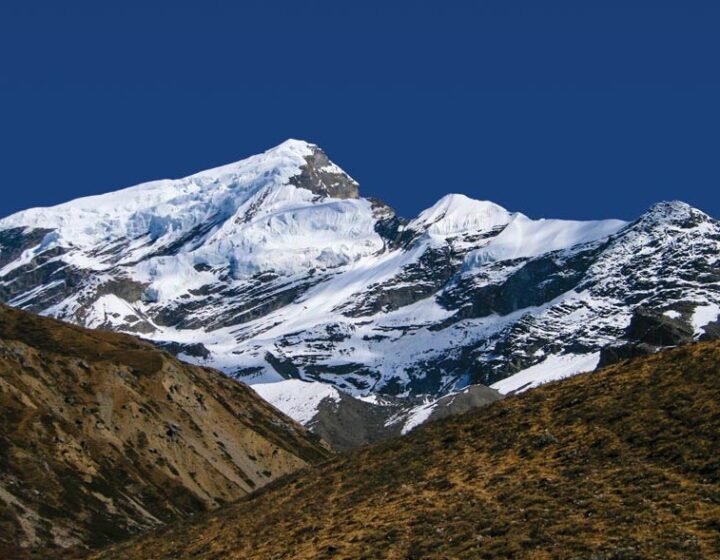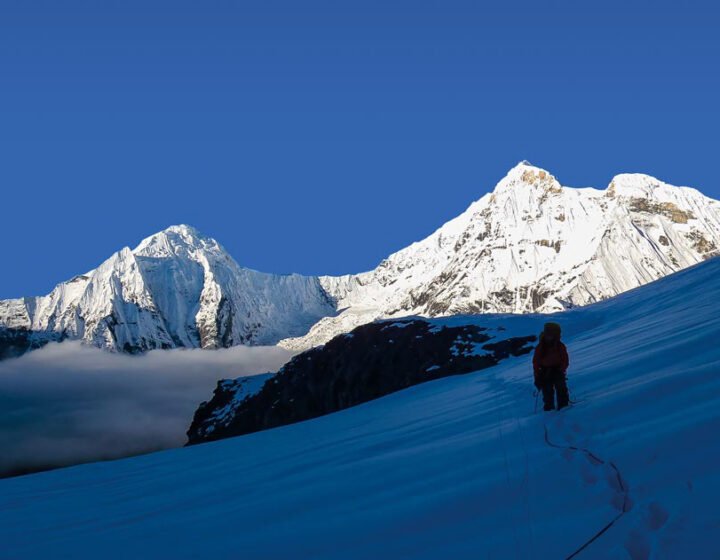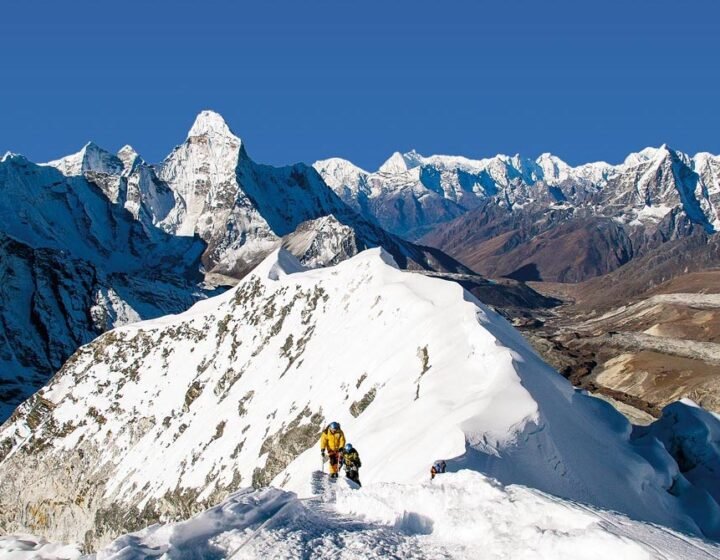- Details
Detailed itinerary
Itinerary- Tour Includes/Excludes
- Useful Info
- Trip Map
- FAQ
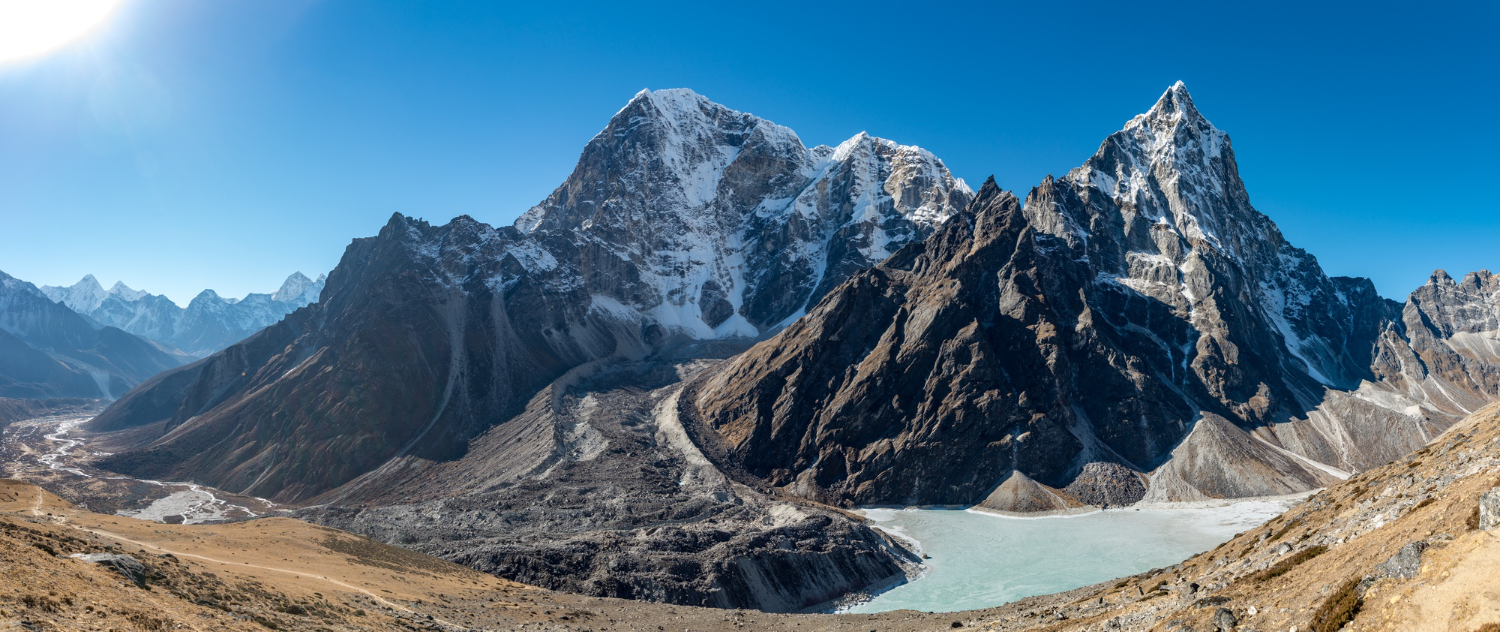
Trip overview
Mera Peak trekking is Nepal’s tallest climbing peak, reaching at 6,476m. We will visit the Makalu Barun National Park and see diverse types of flora as well as magnificent animals and birds.
Mera Peak offers a complete panorama of Chamlang, Kangchenjunga, Makalu, and Baruntse in the east and Cho-Oyu, Ama Dablam, and Kangtega in the west. To the north, Everest can be seen via the enormous unclimbed south face of Lhotse and the Nuptse/Lhotse ridge. We will also get a spectacular view of the high summits of Lhotse, Choyu, Ama Dablam, Kanchenjunga, and Makalu. Likewise, we will go through numerous mountain people’s towns, and lovely woods, and experience native culture and lifestyle. during the trial, we will encounter the magical Hinku valley, which will once again provide us with stunning vistas of the mountains. The trail offers an exciting and thrilling experience to all its energetic climbers.
Tenzing Norway Sherpa and Sir Edmund Hillary, the first Mount Everest climbers, established the practice of ascending the Mera peak before and after the Everest expedition. Since then, its popularity has never waned; rather, it has grown year after year. Climbing Mera Peak is used to prepare for the Everest ascent.
Every year, many climbers arrive in Nepal simply to scale Mera Peak. Mountaineering beginners outnumber professional climbers. Mera Peak’s climbing and difficult terrain are suitable for beginners to lace their shoes. This is why it is regarded as the best mountain to begin a climbing adventure.
During Mera Peak climbing, novices get to try out crampons, ice axes, and other mountaineering equipment for the first time. However, this climbing isn’t only about the rise and descent. The trek to Mera Peak is lengthy but a wonderful and gorgeous portion of the planet.
From the top of Mera Peak, visitors may see four eight-thousanders: Mt Everest (8,848m), Mt Makalu (8,643m), Mt Cho Oyu (8,201m), and Mt Lhotse (8,586m). The whole trial is pleasing and beautiful to climbers with its amazing gleaming mountain vibes. What better gift could there be for a mountain lover?
Mera Peak’s trek takes you via the renowned Khumbu region. And this region has it all: distinctive Sherpa towns, lush forests, swinging suspension bridges, traditional gompas, monasteries, prayer flags, and many other things. It would take far too many words to describe what this Mera peak climbing adventure has to offer.
Highlights:
- Expedition of Mera Peak climbing (6,461m), the highest trekking peak in Nepal.
- The Everest region’s legends.
- The snow-capped views of Mt. Everest (8,848m), Mt. Lhotse (8516m), Mt. Cho Oyu (8,188m), and others.
- Greetings and warm hospitality from the Khumbu region (Sherpa community).
- Spend some time walking in the most beautiful landscape.
- The best pick for mountaineering beginners
Itinerary
Day 1: Arrival in KathmanduThe team will help you till you check into the hotel. After you've completed all of your tasks, you can relax on your bed after a long journey.
Pashupatinath Temple, Kathmandu Durbar Square, Patan Durbar Square, Boudhanath Stupa, Swyambhunath Stupa, and other world heritage monuments can be found in Kathmandu.
All of these sites are worth seeing because of their cultural value, although it is impossible to tour them all in a single day. You must select three to four locations from the available options. It will be one of the most exciting days of the voyage as you trace your ancestors back to the old civilization with a site tour.
Following your successful city tour, you will go to the marketplace to do some last-minute shopping. Thamel is the best shopping location in Nepal for all trekkers and climbers.
Get ready to fly from Kathmandu to Lukla. When you arrive in Lukla, you will be issued a Local Area Permit by the local administration, which will allow you to travel further.
After obtaining the permit, you will depart from Lukla in the direction of Chhuthang (3020m). You will pass through several small Sherpa communities dotted along the route.
After finishing your breakfast in Chhuthang, you will go to Tuli Kharkha (4,600m). As you continue on the trail, you will come across a steep rocky hill. This will be the most difficult ascent of your Mera Peak climbing expedition, as you will exert all of your efforts to reach the top of Zatrawala Pass (4,600m).
The trek today will take you to the Hinku valley in the Khumbu region. The trek will begin with a moderate descent directly in front of mountain views. And the track will gradually get more erratic, with regular uphills and downhills. But you'll like the journey nevertheless, because you'll be sliding through a verdant and lush forest of rhododendrons, pines, and oaks.
Today's target is Thangnak, and you must retrace your travels along the Hinku River's riverbed. This river-bordered trail leads to Gondishung. While walking in the shadow of Mera Peak, you will arrive at Gondishung and enjoy lunch there. Thangnak is a pastureland where villagers come solely in the summer to graze their yaks. However, there are a few rudimentary tea shops where Mera Peak climbers can get food and spend the night.
The trail will bring you as close to the Hinku Nap and Shar glaciers as possible. Keep an eye on the path and proceed with caution; the glacier's path is the most challenging.
Following that, there will be a strong hill climb that will lead to Khare. This climb will be more difficult than the previous ones. As a result, save some energy before beginning this ascent. The 3 to 4-hour upward journey will conclude when you reach Khare, where you can take in as many Mera peak vistas as possible. Khare is the acclimatization site for the Mera Peak climbing plan, so you'll spend another day here tomorrow.
You will be at a higher risk of altitude sickness if you do not acclimate before the summit day. Your body will require some time to adjust to the higher altitudes. As a result, the Mera Peak climbing program includes a rest or acclimatization day at Khare. On this day, you will spend the full day in and around Khare, which serves as the entrance to Mera Base Camp.
You will depart Khare early in the morning in order to reach Mera Base Camp (5300m) on this day. This stretch is not as easy as the previous ones; rather, it is technically challenging. The steep Mera glacier path will lead you to base camp. You will rest at your pals' campground and eat excellent meals prepared by them. A night in the camp, just under the open and star-studded sky, is a really tempting night. Lay back comfortably because tomorrow is another crucial day for the expedition.
The trail from base camp leads to the Mera La Pass, a hard climb through rocky and snowy terrain. The track does not appear to drop down after the Mera La Pass; it is as steep as the first segment.
You can breathe in the cold breeze from the Mera High Camp while admiring the spectacular mountain scenery. Everest, Nuptse, Baruntse, Chamlang, Makalu, and other peaks are plainly seen. While you take in the scenery, your crew member will prepare the campsite for your stay.
This is the most significant day of your Mera Peak Climb since you will reach the peak. With all of your mountaineering gear prepared, you'll be on your way before the first rays of dawn. To reach the top before midday, you must begin climbing early in the morning, about 2 a.m. After 12 p.m., the Mera peak summit experiences high winds, which might exacerbate difficulties.
The vistas of multiple eight-thousanders and other peaks will leave you speechless once you reach the summit. Mt. Everest, Mt. Cho Oyu, and Mt. Makalu are among them.
It is possible that your summit day will change due to severe weather. As a result, as the reserve day, this day is effective in the event of inclement weather on the scheduled date. If everything went as planned on the Mera Peak Climbing Program, you can continue the expedition.
Before arriving in Kothe, you will pass through Thangnak. Thangnak is the same location where you stayed one night upon arrival. However, you do not need to remain in Thangnak this time because the Kothe is easily reachable within 3 to 4 hours of trekking.
Thuli Kharka is located near the Hinku valley and may be reached after a 5-to 6-hour hike from Kothe.
You'll be visiting Thuli Kharka for the second time to have a good time. If you missed any of the mountain vistas from the Thuli Kharka, now is the opportunity to make up for lost time. Thuli Kharkha presents Mera Central's vigilant show and its other faces.
This walk will be enjoyable because you will depart from Thuli Kharka and arrive in Lukla in a single day. You will pass through Zatrawala Pass once more before arriving at Lukla. You must first summit the pass before beginning the downhill descent. The Zatrawala Pass offers views of most of the Everest summits.
Your time in Lukla will come to an end when you board an early flight to Kathmandu.
After taking in the overhead beauty of Nepal, you will arrive at Kathmandu airport in 45 minutes. Our personnel will transport you to your accommodation.
On this leisure day, you can visit areas like Thamel, Naxal, and Durbar Marg. After the tour is successfully completed, the entire team will have dinner and say their goodbyes in the evening.
You will be transferred from your accommodation to the airport for your flight. It was an unforgettable journey with you. See you soon on your next climb.
Included
- Customize both domestic and international flight arrival and departure transfers.
- As per the plan, standard hotel accommodation in Kathmandu on twin sharing BB basis.
- As specified in the Mera and Island peak climbing agenda, a welcome group supper will be held.
- The schedule includes a half-day guided city tour with world heritage entrance fees.
- Lukla Kathmandu and airport tax as specified in the itinerary
- All meals (breakfast, lunch, and dinner) and drinking water were provided throughout the trip and ascent.
- Accommodation at a teahouse while trekking and a tented camp while climbing
- Climbing royalty and government levies apply to both twin peaks (Mera and Island).
- Climbing Clinic Course at Twin Peaks Base Camp
- All necessary Personal and Group Climbing Items: La Sportiva climbing boot, crampons, climbing rope, ice axe, Jumar, harness, the figure of eight, Carabiner, as well as required camping gear while climbing.
- Gear for the journey, including a sleeping bag, fleece inner lining, down jacket, rain poncho, and other items.
- Supplemental Oxygen with normal / Gamow Bag (A life-saving device in the event of Acute Mountain Sickness), as well as a comprehensive First Aid Kit
- Climbing guides with extensive expertise, including all allowances and expenses.
- Professional and experienced trekking group leader certified in Wilderness First Aid, as well as trip support team equipped with appropriate equipment and insurance
- In case of emergency, use a satellite phone.
- Trek Duffle pack and trekking map are provided at no cost.
- Peak climbing certificates are awarded by the Nepal Government's specific body.
- Makalu and Everest National Parks, as well as all government levies, are included.
Not Included
- Nepal entry visa fees, any type of travel insurance, international airfare
- In cities, all drinks and main meals are included.
- Tips and personal expenses such as a hot shower, battery charge, phone, and beverage drinks
Useful Info
- You must be aware of the season, make sure that you must be careful while traveling through December and mid-February.
- Be ready for altitude changes and keep buffering day to minimize the risk.
- Remember to keep a climbing permit.
- Bring warm clothes with you, especially the zipper ones.
- Remember to Hydrate yourself while climbing so always keep a water bottle with you.
- Try to keep a light backpack with essential equipment and clothes.
- Follow the advice from experts and guides.
- In cases of special medical situations. Please take your doctor’s advice and if you are physically and mentally unwell then please avoid climbing.
Trip Map
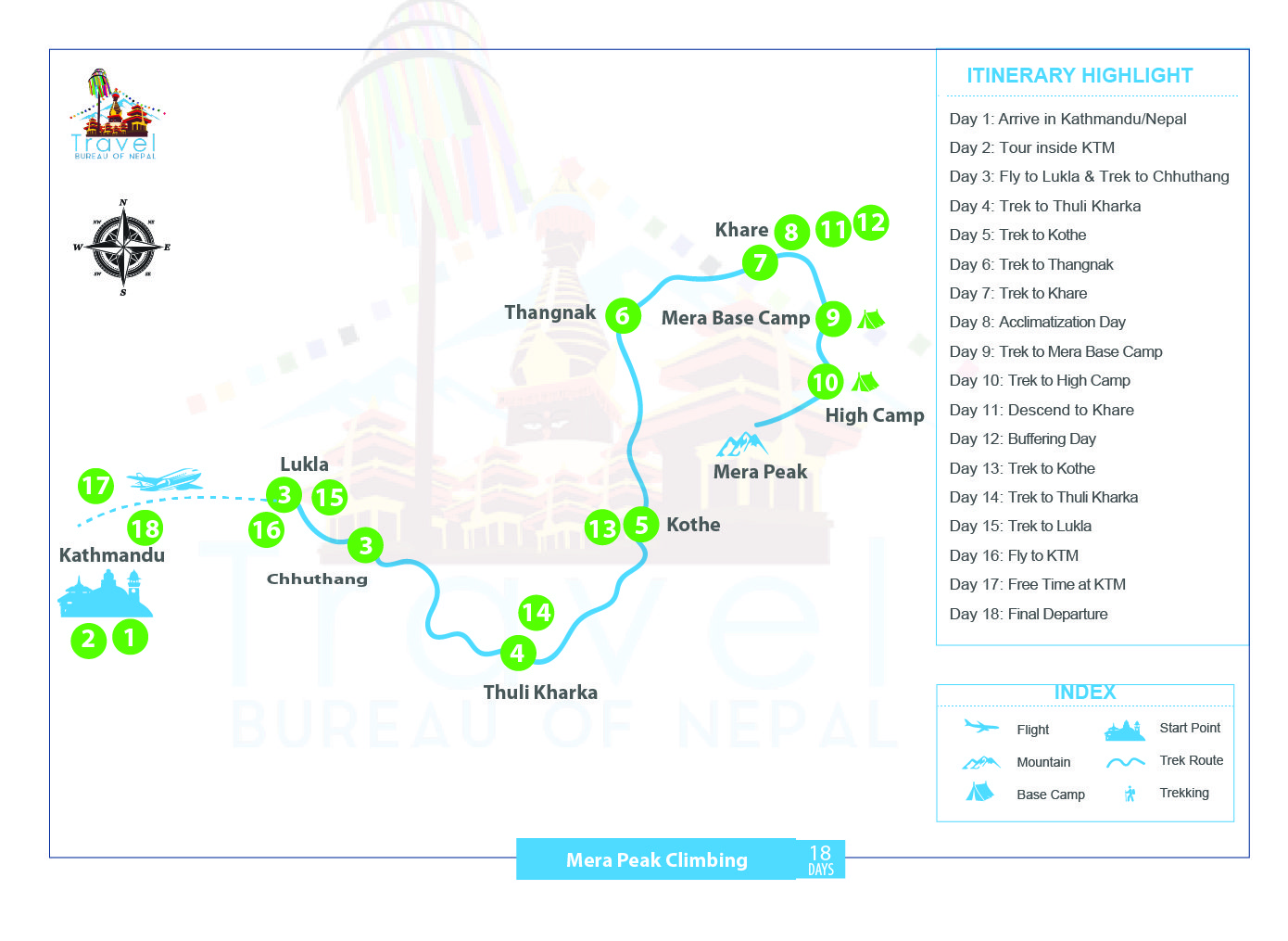
FAQs
-
Which is the best season for climbing Mera peak?
The temperature in higher levels is always unpredictable such as snowfall and temperature drop, for the climber the warm temperature, rain or snow-free days are most suitable.
-
What kind of physical fitness do climbers need?
All climbers need to boost their physical fitness and for that, you are highly recommended to join fitness sessions such as running, gym workouts, hiking, etc.
-
What is the maximum altitude of Mera Peak Climbing?
Mera peak is 6,476m (i.e.,21,247ft) high and is one of the highest trekking peaks in the world.
-
Do I have to carry an oxygen cylinder and Gamow Bag?
Normally you don’t need to carry an oxygen cylinder or Gamow Bag. Our crew members will always pose emergency supplies for uncertain cases. Therefore, you personally don’t have to carry all these things.

